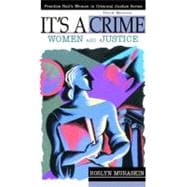
| Foreword | xi | ||||
|
|||||
| Preface | xii | ||||
| About the Authors and Contributors | |||||
| Acknowledgments | xxi | ||||
| SECTION I HISTORICAL DEVELOPMENT OF WOMEN'S ISSUES | 1 | (50) | |||
|
3 | (9) | |||
|
|||||
|
12 | (18) | |||
|
|||||
|
30 | (21) | |||
|
|||||
| SECTION II WOMEN AND THE LAW | 51 | (46) | |||
|
53 | (24) | |||
|
|||||
|
|||||
|
77 | (9) | |||
|
|||||
|
86 | (11) | |||
|
|||||
| SECTION III WOMEN, DRUGS, AND AIDS | 97 | (76) | |||
|
99 | (18) | |||
|
|||||
|
117 | (12) | |||
|
|||||
|
|||||
|
129 | (23) | |||
|
|||||
|
152 | (21) | |||
|
|||||
|
|||||
|
|||||
| SECTION IV WOMEN IN PRISON | 173 | (132) | |||
|
175 | (21) | |||
|
|||||
|
|||||
|
196 | (13) | |||
|
|||||
|
|||||
|
209 | (11) | |||
|
|||||
|
220 | (12) | |||
|
|||||
|
232 | (26) | |||
|
|||||
|
258 | (15) | |||
|
|||||
|
|||||
|
273 | (16) | |||
|
|||||
|
289 | (16) | |||
|
|||||
| SECTION V WOMEN: VICTIMS OF VIOLENCE | 305 | (106) | |||
|
307 | (23) | |||
|
|||||
|
330 | (19) | |||
|
|||||
|
349 | (14) | |||
|
|||||
|
363 | (17) | |||
|
|||||
|
|||||
|
|||||
|
380 | (14) | |||
|
|||||
|
394 | (17) | |||
|
|||||
| SECTION VI WOMEN IN CRIMINAL JUSTICE PROFESSIONS | 411 | (56) | |||
|
413 | (16) | |||
|
|||||
|
|||||
|
429 | (12) | |||
|
|||||
|
441 | (9) | |||
|
|||||
|
450 | (17) | |||
|
|||||
| SECTION VII WOMEN AND CRIME | 467 | (48) | |||
|
469 | (16) | |||
|
|||||
|
485 | (12) | |||
|
|||||
|
|||||
|
497 | (18) | |||
|
|||||
|
|||||
| SECTION VIII GIRLS AND DELINQUENCY | 515 | (74) | |||
|
517 | (27) | |||
|
|||||
|
|||||
|
|||||
|
|||||
|
544 | (26) | |||
|
|||||
|
|||||
|
570 | (19) | |||
|
|||||
|
|||||
| SECTION IX CONCLUSIONS | 589 | (6) | |||
|
|||||
| Index | 595 |
The New copy of this book will include any supplemental materials advertised. Please check the title of the book to determine if it should include any access cards, study guides, lab manuals, CDs, etc.
The Used, Rental and eBook copies of this book are not guaranteed to include any supplemental materials. Typically, only the book itself is included. This is true even if the title states it includes any access cards, study guides, lab manuals, CDs, etc.